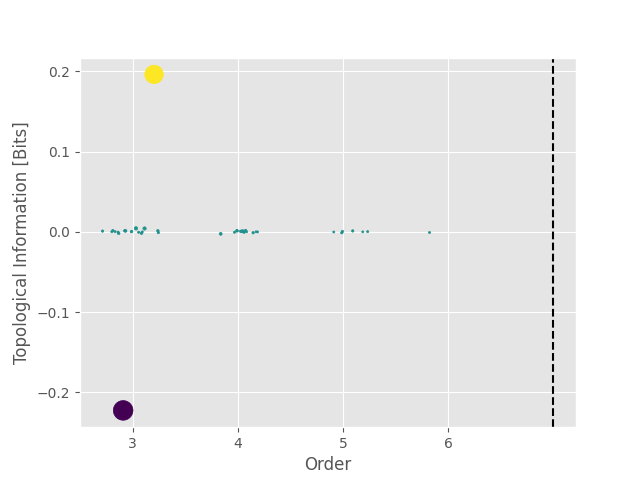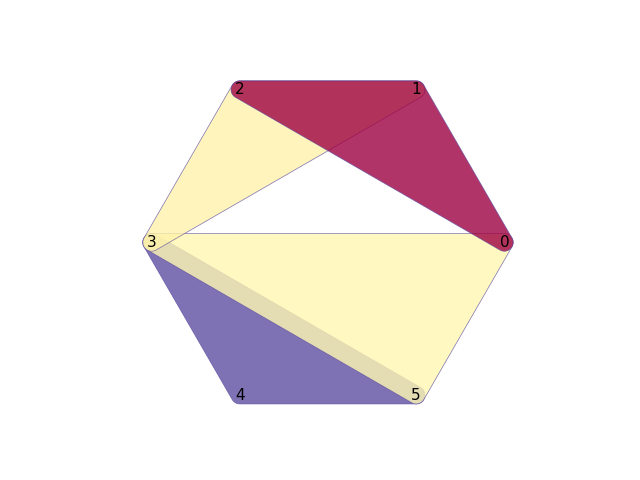Note
Go to the end to download the full example code.
Inspect and plot Higher-Order Interactions#
This example illustrates how to : 1. Inspect and analyse metric’s output 2. Plot Higher-Order Interactions
import matplotlib.pyplot as plt
import numpy as np
import xgi
from hoi.metrics import InfoTopo
from hoi.plot import plot_landscape
from hoi.utils import get_nbest_mult
plt.style.use("ggplot")
Simulate data#
In this first part, we simulate data to showcase how to analyse results
# create random data
np.random.seed(42)
x = np.random.rand(200, 6)
# inject redundancy between [0, 1, 2]
x[:, 0] += x[:, 1]
x[:, 2] += x[:, 1]
# inject synergy between [3, 4, 5]
x[:, 3] += x[:, 4] + x[:, 5]
Estimate HOI#
The we can estimate the HOI. Here, we are going to use the InfoTopo metrics but you can use any implemented metric.
0%| | 0/6 [00:00<?, ?it/s]
17%|█▋ | Entropy H(1): 1/6 [00:00<00:00, 5.25it/s]
33%|███▎ | Entropy H(2): 2/6 [00:00<00:00, 5.07it/s]
50%|█████ | Entropy H(3): 3/6 [00:00<00:00, 5.64it/s]
67%|██████▋ | Entropy H(4): 4/6 [00:00<00:00, 6.32it/s]
83%|████████▎ | Entropy H(5): 5/6 [00:00<00:00, 6.70it/s]
100%|██████████| Entropy H(6): 6/6 [00:00<00:00, 7.03it/s]
Mutual information: 0%| | 0/42 [00:00<?, ?it/s]
Mutual information: 100%|██████████| 42/42 [00:00<00:00, 15625.40it/s]
Get a summary of the results#
To get a summary table of the results, you can use the
hoi.utils.get_nbest_mult() function. This functions returns a Pandas
DataFrame with the highest and lowest values of hoi.
summary = get_nbest_mult(hoi, model=model)
print(summary)
index order hoi multiplet
0 0 3 0.196290 [0, 1, 2]
1 10 3 0.004351 [1, 2, 3]
2 13 3 0.004202 [1, 3, 4]
3 30 4 0.001593 [1, 2, 3, 4]
4 2 3 0.001399 [0, 1, 4]
5 27 4 -0.001132 [0, 2, 3, 5]
6 14 3 -0.001671 [1, 3, 5]
7 8 3 -0.001762 [0, 3, 5]
8 24 4 -0.002511 [0, 1, 3, 5]
9 19 3 -0.222631 [3, 4, 5]
For the InfoTopo estimator, positive values of HOI refer to redundant interactions while negative values of HOI refer to synergistic interactions. As you can see from the summary table, we retrieve the multiplet [0, 1, 2] with the largest value and [3, 4, 5] with the smallest.
Landscape plot#
The landscape plot can be used to visualize how the information spreads across orders. In our example, we only injected redundancy and synergy between triplets.
plot_landscape(hoi, model=model, kind="scatter")
plt.show()

Plotting individual multiplets#
Alternatively, you can use the xgi Python package to plot individual multiplets. The example below the multiplets with the 2 highest redundancy and the two highest synergy.
# get summary
summary = get_nbest_mult(hoi, model=model, minsize=3, maxsize=3, n_best=2)
# extract the hoi values and the multiplets
hoi_order_3 = summary["hoi"]
mult_order_3 = summary["multiplet"]
# define an hypergraph object
H = xgi.Hypergraph()
# add the 6 nodes and define a circular layout
H.add_nodes_from(np.arange(6))
pos = xgi.drawing.layout.circular_layout(H)
# add edges
H.add_edges_from(mult_order_3.tolist())
# plot the hypergraph
ax, collections = xgi.draw(
H,
pos=pos,
node_labels=True,
font_size_nodes=11,
node_size=0,
edge_fc=hoi_order_3,
edge_fc_cmap="Spectral_r",
alpha=0.8,
hull=True,
)
plt.show()
# sphinx_gallery_thumbnail_number = 2

Total running time of the script: (0 minutes 1.753 seconds)
